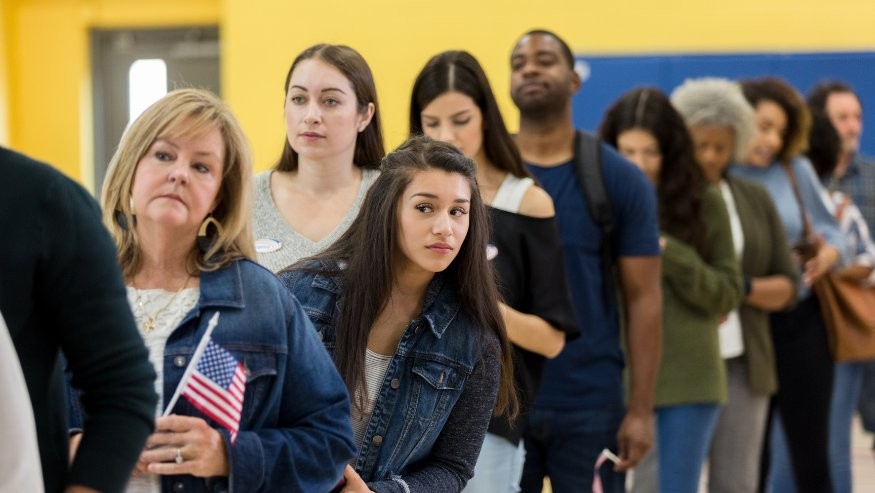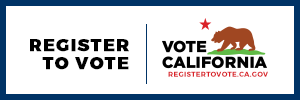Learning to Vote

A generational responsibility
Children are not born with a Democracy gene. Each generation has a responsibility to prepare children to be responsible citizens. Schools play a critical role in this process — in fact, a core purpose of public education is to teach children how to be good citizens.
California High School Voter Education Weeks: September 15 through September 26, 2025.
Today’s headlines reinforce why this is so important. Whether it is states trying to rig voting in favor of one group or getting enough votes to support funding for your local schools, all voices should be heard, including the voices of teens.
What teens should learn in school about voting
In high school, California requires students to take a course in U.S. government. It's a graduation requirement. The class covers the basics of voting:
“As a practical matter, students should know
how to register to vote — both online and by mail —
what the requirements are for registration;
how to request, fill out, and return an absentee ballot;
what to expect on election day;
how to find a polling place; and
where and how to access and understand the voter information pamphlet and other materials to become an informed voter.”
— California History Social Science Frameworks
High School Voter Education Weeks: California law designates the last two full weeks in April and September as High School Voter Education Weeks. This gives schools and students the opportunity to partner with county elections officials to promote civic education and participation and foster an environment that cultivates lifelong voters and active citizens.
The Secretary of State and the Superintendent of Public Instruction have jointly provided a menu of resources to kick this off.
The curriculum of California's high school course on U.S. Government covers a lot more than the logistics of voting, of course. It's meant to be an engaging course that helps prepare students for civic life. For example, it encourages discussion of controversial issues relating to democracy, such as these:
|
Sample discussion prompts from the curriculum framework (PDF) |
|---|
|
Do citizens have rights that the state must respect, and if so what are they? |
|
What is the role of civil dissent and when is it necessary? |
|
Why have some revolutions been followed by purges of dissidents, mass arrests of political opponents, murder of “class enemies,” suppression of free speech, abolition of private property, and attacks on religious groups? |
|
Why do ordinary people risk their lives to flee or transform authoritarian states? |
The role of the state in youth voting
The chief election officer for the state of California is the Secretary of State. The office plays a significant role in boosting voter registration and participation rates, including among young voters.
In California, voters can register with a simple form, on paper or online, up to 15 days before an election. Actually, even if you miss that date, you can still vote using a provisional ballot. California’s online registration has dramatically increased youth voter participation, and pre-registration has had an even bigger impact:
In California, young people don't have to wait until they are 18 to register to vote. Pre-registration for 16- and 17-year-olds is available through California’s online voter registration application. It's a fairly new system, introduced in 2017. Under the state's Motor Voter system, the state automatically pre-registers all eligible sixteen- and seventeen-year olds to vote when they receive a California Driver’s License or California State I.D.
The office of the Secretary of State reports annually on student voter registration trends.
Young people are underrepresented in California
California’s young adults (those under 26) tend to be weak participants in elections. They register to vote at lower rates than older Californians. Those who do register tend to be less likely than older Californians to cast their ballot.
According to research by the CIRCLE program at Tufts University, low youth participation in voting is a persistent, national problem. Young people in California (age 18-19) tend to participate at rates a bit lower than the national average, but some counties do better than others at engaging students as voters.
Getting students involved
By definition, each year's young voters are new voters. Elections happen only occasionally, so it is challenging to build and sustain ongoing programs that effectively set the stage for young people to participate in them. California, like other states, has been struggling to develop programs that address this challenge. Below are some of them.
- High School Voter Education Weeks Resolution (PDF)
- Best Practices for voter outreach in high schools, shared by California Counties (PDF)
- Pre-Registration Flier (PDF)
- Student Poll Worker Flier (PDF)
- Citizens Redistricting Commission Resources for High School Teachers (PDF)
Excused absences: Students in grades 6 to 12 are eligible to receive one excused absence a year to participate in a political or civic event, provided the student notifies the school prior to the absence. This became law with the passage of Senate Bill 955 (2022).
Poll workers: Starting at age 16, high school students can earn money while learning how elections are run by serving as a student poll worker on election day. Depending on where you live, you may be eligible for a stipend ranging from $65 to $150.
To find out what it takes to become a student poll worker and how to sign up, contact your County Elections Office. (For example, Los Angeles has a well-developed plan.)
Mock Elections: In 2024, more than 70,000 students participated in the California Mock Election. Mock Elections help students understand the issues on the ballot and give them a chance to practice voting. (Term paper topic suggestion: The results of the 2024 Mock election are here. (Also available: 2022) How did students' votes differ from the election results?)
Civic Learning Award: The Civic Learning Award celebrates public schools that effectively engage students in civic learning. Co-sponsored by the Chief Justice of the California Supreme Court and the California State Superintendent of Public Instruction, the program also identifies models that can be replicated in other schools.
California Students Vote Project: California was the first state to build partnerships across the state’s major higher education systems to empower students to participate in the democratic process. The California Students Vote Project aims to increase voter education, voter registration, and outreach among college students.
College Bowl: The California University and College Ballot Bowl is a friendly biennial competition among higher education systems: which will register the most college students to vote? Ready for a quiz? Which university won the college bowl in 2022? No clues. You have to search for the answer.
Empowerment Act: The Student Civic and Voter Empowerment Act requires each California Community College and California State University campus, and requests each University of California campus, to take the following actions:
- Distribute, in consultation with the California Secretary of State, campuswide emails to all students with specified voting- and election-related dates and information, and to include specific dates on all print and online academic calendars.
- Post on social media reminders to students of specified voter-related dates and information.
- Designate one person per campus as the Civic and Voter Empowerment Coordinator with specified responsibilities, including developing a Civic and Voter Empowerment Action Plan.
|
How parents and schools can help: Some basics |
|
|---|---|
|
Encourage eligible students to register to vote online. One idea: Make voter education an ongoing activity of your PTA. Put this logo on your school and PTA websites and link it to registertovote.ca.gov. |
 |
|
Encourage 16 and 17 year olds to pre-register online. |
|
|
Join or create a voter registration drive. Consult with your local League of Women Voters. |
|
|
Ask what your school administration is doing to promote civic learning: - Is it participating in Mock Elections? - Has it applied for the Civic Learning Award? - Are students volunteering to be poll workers? - For more ideas, read this post in the Ed100 blog. |
|
Does your school have a great program that helps high school students become active voters? Share what your school is doing with Ed100 readers in the comment section at the end of this blog post.
This post was updated August 2025
Tags on this post
Civics Student voice VoteAll Tags
A-G requirements Absences Accountability Accreditation Achievement gap Administrators After school Algebra API Arts Assessment At-risk students Attendance Beacon links Bilingual education Bonds Brain Brown Act Budgets Bullying Burbank Business Career Carol Dweck Categorical funds Catholic schools Certification CHAMP Change Character Education Chart Charter schools Civics Class size CMOs Collective bargaining College Common core Community schools Contest Continuous Improvement Cost of education Counselors Creativity Crossword CSBA CTA Dashboard Data Dialogue District boundaries Districts Diversity Drawing DREAM Act Dyslexia EACH Early childhood Economic growth EdPrezi EdSource EdTech Education foundations Effort Election English learners Equity ESSA Ethnic studies Ethnic studies Evaluation rubric Expanded Learning Facilities Fake News Federal Federal policy Funding Gifted Graduation rates Grit Health Help Wanted History Home schools Homeless students Homework Hours of opportunity Humanities Independence Day Indignation Infrastructure Initiatives International Jargon Khan Academy Kindergarten LCAP LCFF Leaderboard Leadership Learning Litigation Lobbyists Local control Local funding Local governance Lottery Magnet schools Map Math Media Mental Health Mindfulness Mindset Myth Myths NAEP National comparisons NCLB Nutrition Pandemic Parcel taxes Parent Engagement Parent Leader Guide Parents peanut butter Pedagogy Pensions personalized Philanthropy PISA Planning Policy Politics population Poverty Preschool Prezi Private schools Prize Project-based learning Prop 13 Prop 98 Property taxes PTA Purpose of education puzzle Quality Race Rating Schools Reading Recruiting teachers Reform Religious education Religious schools Research Retaining teachers Rigor School board School choice School Climate School Closures Science Serrano vs Priest Sex Ed Site Map Sleep Social-emotional learning Song Special ed Spending SPSA Standards Strike STRS Student motivation Student voice Success Suicide Summer Superintendent Suspensions Talent Teacher pay Teacher shortage Teachers Technology Technology in education Template Test scores Tests Time in school Time on task Trump Undocumented Unions Universal education Vaccination Values Vaping Video Volunteering Volunteers Vote Vouchers Winners Year in ReviewSharing is caring!
Password Reset
Search all lesson and blog content here.
Login with Email
We will send your Login Link to your email
address. Click on the link and you will be
logged into Ed100. No more passwords to
remember!















Questions & Comments
To comment or reply, please sign in .
Carol Kocivar August 27, 2025 at 2:12 pm
The California State Archives presents their newest exhibit titled “The Journey to Democracy: Celebrating the Sixtieth Anniversary of the Voting Rights Act.” This exhibit explores what is arguably the most important civil rights legislation enacted by Congress in the 20th century with facsimiles of historic photographs and documents from the Library of Congress and the Lyndon Baines Johnson Library and Museum supplemented with original records from the collections of the State Archives.
https://www.sos.ca.gov/archives/public-events/exhibits-2